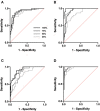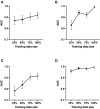Superiority of Supervised Machine Learning on Reading Chest X-Rays in Intensive Care Units
- PMID: 34722558
- PMCID: PMC8554032
- DOI: 10.3389/fmed.2021.676277
Superiority of Supervised Machine Learning on Reading Chest X-Rays in Intensive Care Units
Abstract
Purpose: Portable chest radiographs are diagnostically indispensable in intensive care units (ICU). This study aimed to determine if the proposed machine learning technique increased in accuracy as the number of radiograph readings increased and if it was accurate in a clinical setting. Methods: Two independent data sets of portable chest radiographs (n = 380, a single Japanese hospital; n = 1,720, The National Institution of Health [NIH] ChestX-ray8 dataset) were analyzed. Each data set was divided training data and study data. Images were classified as atelectasis, pleural effusion, pneumonia, or no emergency. DenseNet-121, as a pre-trained deep convolutional neural network was used and ensemble learning was performed on the best-performing algorithms. Diagnostic accuracy and processing time were compared to those of ICU physicians. Results: In the single Japanese hospital data, the area under the curve (AUC) of diagnostic accuracy was 0.768. The area under the curve (AUC) of diagnostic accuracy significantly improved as the number of radiograph readings increased from 25 to 100% in the NIH data set. The AUC was higher than 0.9 for all categories toward the end of training with a large sample size. The time to complete 53 radiographs by machine learning was 70 times faster than the time taken by ICU physicians (9.66 s vs. 12 min). The diagnostic accuracy was higher by machine learning than by ICU physicians in most categories (atelectasis, AUC 0.744 vs. 0.555, P < 0.05; pleural effusion, 0.856 vs. 0.706, P < 0.01; pneumonia, 0.720 vs. 0.744, P = 0.88; no emergency, 0.751 vs. 0.698, P = 0.47). Conclusions: We developed an automatic detection system for portable chest radiographs in ICU setting; its performance was superior and quite faster than ICU physicians.
Keywords: ICU; adaptive ensemble learning; chest radiographs; computer-aided detection; deep convolutional neural network; machine learning technique.
Copyright © 2021 Tanaka, Nakada, Takahashi, Dozono, Yoshimura, Yokota, Horikoshi, Nakaguchi and Shinozaki.
Conflict of interest statement
KS has a patent right of metabolic measurements in critically ill patients and grant/research supports from Nihon Kohden Corp. This does not alter the authors' adherence to all the journal's policies on sharing data and materials. TNakad, KT, TD, YY, and TNakag are the inventor of the patent. TNakad is the CEO of Smart119 Inc. and owns the stock. The remaining authors declare that the research was conducted in the absence of any commercial or financial relationships that could be construed as a potential conflict of interest.
Figures



References
LinkOut - more resources
Full Text Sources

